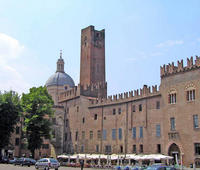You are in: Europe -> Italy -> Mantua and Sabbioneta, and traditional search or Image Gallery will yield results of this site only
Mantua and Sabbioneta
| Site number: | 1287 |
|
| Type of site: | Cultural | |
| Date: | 11th century | |
| Date of Inscription: | 2008 | |
| Location: | Europe, Italy, province of Mantua, Po valley | |
Up to 75 images are shown here. Click on each for more details or on Image Gallery for more images.
| Description: | Located in northern Italy’s Po valley, Mantua and Sabbioneta embody two aspects of Renaissance town planning: Mantua demonstrates an existing city’s renewal and expansion, while Sabbioneta, 30 km away, illustrates the execution of the period’s theories regarding to planning the ideal city. As expected, Mantua holds an irregular layout with elements showing various stages of its growth since the Roman period; it consists of countless medieval edifices amongst them a rotunda from the 11th century and a Baroque theatre. Sabbioneta, on the other hand, having been created under the rule of one person, Vespasiano Gonzaga Colonna (late 16th century), expresses a single-period city on a right angle grid layout. Both cities bear witnesses to the urban, architectural and artistic accomplishments of the Renaissance, linked by way of the ruling Gonzaga family’s visions and actions. The two towns are significant for their architectural value and for their major role in the spreading of Renaissance culture. Fostered by the Gonzaga family, the towns’ morphology and architecture is infused with the ideals of the Renaissance. --WHMNet paraphrase from the description at WHC Site, where additional information is available. | |
| Sabbioneta is a town in Lombardy, Italy, in the province of Mantua, about 30 km north of Parma, not far from the N. bank of the Po River, 19 m. above sea-level. As of 2007 Sabbioneta had an estimated population of 4,337. It was inscribed on the World Heritage List in 2008. Its period of prosperity and artistic patronage was under Vespasiano Gonzaga (d. 1591), who was its duke; by him it was transformed into a small Residenzstadt. It was well fortified and built, and from this period date the ducal palace (now the Municipio), the theatre designed by Vincenzo Scamozzi (1548-1616), and other buildings. The church and the summer palace contain frescoes by artists of the Campi family of Cremona. It was also during this period that it became a minor musical centre; composers such as Benedetto Pallavicino were employed here by Vespasiano, prior to his moving to the main Gonzaga city of Mantua.The town is also known for its historic Jewish Ghetto and particularly for its Hebrew printing-press. In 1567 Tobias Foa set up the press; he had, however, published certain "anti-Christian books" and his career was "forcibly ended". His work and possibly his type were taken up by a Christian printer, Vicenzo Conte. --Wikipedia. Text is available under the Creative Commons Attribution-ShareAlike License. | ||
| Source: | http://whc.unesco.org/en/list/1287 | |
| Reference: | 1. UNESCO World Heritage Center, Site Page. | |







